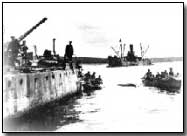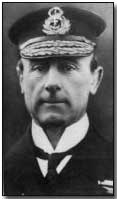Encyclopedia - Scapa Flow
 Scapa Flow was the
designated anchorage of the British Royal Navy's
Grand Fleet during the
First World War. A natural expanse of sea, Scapa Flow was enclosed by
the Orkney Islands in Scotland and was capable of holding the Grand Fleet
several times over.
Scapa Flow was the
designated anchorage of the British Royal Navy's
Grand Fleet during the
First World War. A natural expanse of sea, Scapa Flow was enclosed by
the Orkney Islands in Scotland and was capable of holding the Grand Fleet
several times over.
When war began Scapa Flow was essentially undefended against the threat of German U-boat attacks. With the Grand Fleet newly relocated to the area from Portsmouth, Plymouth and Chatham high priority was therefore given to securing the area against German assault, the more so once it was discovered that a German submarine had managed to enter the Flow in November 1914.
Thus initial defences were constructed with the sinking of some 21 blockships and the deployment of anti-submarine indicator nets laid at various depths and intended to entangle enemy submarines. Work continued with the laying of defensive minefields and, further supported by gun batteries, Scapa Flow was declared a safe base for the fleet in 1915.
Nevertheless the Grand Fleet occasionally put to sea after scares emerged reporting the presence of German submarines in the area. Grand Fleet commander Sir John Jellicoe later admitted that he lived in constant fear of the potential damage U-boats could wreak upon the Grand Fleet were they to enter Scapa Flow undetected.
It was from Scapa Flow that the Grand Fleet put to sea at the end of May 1916 to engage the German High Seas Fleet in what was to comprise the last great fleet action between two of the world's great naval powers at Jutland.
A tactical victory for Germany (which sunk more shipping) the British claimed the longer term success, since Kaiser Wilhelm II, shocked at the risk he had run of a German naval defeat with its inevitable disastrous consequences, thereafter barred his fleet from again engaging the British in fleet action.
 A
matter of days after the action at Jutland, in June 1916
Lord Kitchener,
the war minister and hero of Khartoum, visited Scapa Flow en route to Russia
on a diplomatic mission. He and his staff subsequently boarded HMS
Hampshire and put to sea through Hoy Sound.
A
matter of days after the action at Jutland, in June 1916
Lord Kitchener,
the war minister and hero of Khartoum, visited Scapa Flow en route to Russia
on a diplomatic mission. He and his staff subsequently boarded HMS
Hampshire and put to sea through Hoy Sound.
It then became clear that the defensive blockships had failed in their aim, for a German U-boat had successfully crossed the Flow and having reached Birsay further north, laid a mine. It was this mine which struck HMS Hampshire on 5 June. Kitchener was killed, stunning the nation.
With the armistice in November 1918 74 ships of the German Navy were instructed to proceed to Scapa Flow to surrender to the British. For some six months the German vessels remained at anchor, food and other supplies from Germany meanwhile running low.
When the local German commander, Admiral Ludwig von Reuter, read details of the Allies' peace terms in The Times newspaper in June 1919, he resolved to scuttle the German fleet when the Grand Fleet were next out performing exercises.
This he proceeded to do on 21 June, with 66 ships in all destroyed, the event spectated by a party of schoolchildren who had travelled to see the ships at Scapa Flow. Upon his eventual return to Germany von Reuter was regarded as a national hero, the saviour of the honour of the German Navy.
In 1919 Scapa Flow lost its status as the fleet's main base to Rosyth in the Firth of Forth; it was however restored with the arrival of renewed war in 1939.
A Kite Balloon was an observation balloon controlled by a cable from the ground.
- Did you know?
